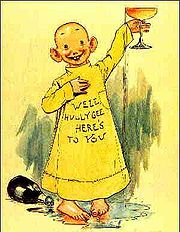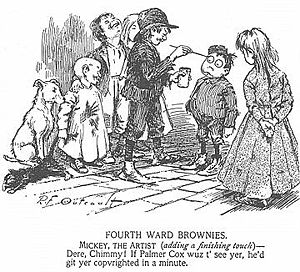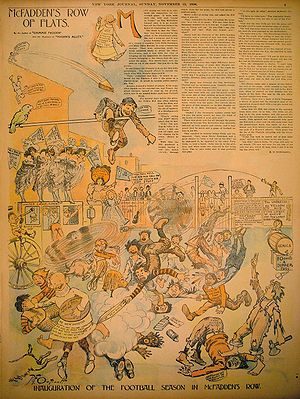
The Yellow Kid
Encyclopedia

Richard F. Outcault
Richard Felton Outcault was an American comic strip writer-artist. He was the creator of the series The Yellow Kid and Buster Brown, and he is considered the inventor of the modern comic strip.-Early life:...
, which became one of the first Sunday supplement comic strip
Comic strip
A comic strip is a sequence of drawings arranged in interrelated panels to display brief humor or form a narrative, often serialized, with text in balloons and captions....
s in an American newspaper, although its graphical layout had already been thoroughly established in political and other, purely-for-entertainment cartoons.
The Yellow Kid was a bald, snaggle-toothed boy who wore a yellow nightshirt and hung around in a ghetto
Ghetto
A ghetto is a section of a city predominantly occupied by a group who live there, especially because of social, economic, or legal issues.The term was originally used in Venice to describe the area where Jews were compelled to live. The term now refers to an overcrowded urban area often associated...
alley filled with equally odd characters, mostly other children.
With a goofy grin, the Kid habitually spoke in a ragged, peculiar ghetto argot
Argot
An Argot is a secret language used by various groups—including, but not limited to, thieves and other criminals—to prevent outsiders from understanding their conversations. The term argot is also used to refer to the informal specialized vocabulary from a particular field of study, hobby, job,...
printed on his shirt, a device meant to lampoon advertising billboard
Billboard (advertising)
A billboard is a large outdoor advertising structure , typically found in high traffic areas such as alongside busy roads. Billboards present large advertisements to passing pedestrians and drivers...
s.
Magazine to newspapers
Outcault drew four black-and-white, highly detailed single panel Hogan Alley cartoons for TruthTruth Magazine
Truth Magazine is a magazine produced by certain preachers within the non-institutional Churches of Christ.Publication began in the fall of 1956 with Bryan Vinson, Jr. as editor and Leslie Diestelkamp and Gordon J. Pennock as associate editors. Cecil Willis served as editor from August 1962 until...
magazine in 1894 and 1895. The character who would later become the Yellow Kid had a minor supporting role in these panels. The fourth cartoon, Fourth Ward Brownies, was reprinted on 17 February 1895 in Joseph Pulitzer
Joseph Pulitzer
Joseph Pulitzer April 10, 1847 – October 29, 1911), born Politzer József, was a Hungarian-American newspaper publisher of the St. Louis Post Dispatch and the New York World. Pulitzer introduced the techniques of "new journalism" to the newspapers he acquired in the 1880s and became a leading...
's New York World
New York World
The New York World was a newspaper published in New York City from 1860 until 1931. The paper played a major role in the history of American newspapers...
where Outcault worked as a technical drawing
Technical drawing
Technical drawing, also known as drafting or draughting, is the act and discipline of composing plans that visually communicate how something functions or has to be constructed.Drafting is the language of industry....
artist. The World published a new Hogan's Alley cartoon less than a month later and this was followed by the strip's first color printing on 5 May 1895. Hogan's Alley gradually became a full-page Sunday color cartoon with the Yellow Kid as its lead character, which was also appearing several times a week.
The strip has been described as "... a turn-of-the-century theater of the city, in which class and racial tensions of the new urban, consumerist environment were acted out by a mischievous group of New York City
New York City
New York is the most populous city in the United States and the center of the New York Metropolitan Area, one of the most populous metropolitan areas in the world. New York exerts a significant impact upon global commerce, finance, media, art, fashion, research, technology, education, and...
kids from the wrong side of the tracks." The Yellow Kid's head was drawn wholly shaved as if having been recently ridden of lice, a common sight among children in New York's tenement ghettos at the time. His nightshirt, a hand-me-down from an older sister, was white or pale blue in the first color strips.
Merchandising


In 1896 Outcault was hired away at a much higher salary to William Randolph Hearst
William Randolph Hearst
William Randolph Hearst was an American business magnate and leading newspaper publisher. Hearst entered the publishing business in 1887, after taking control of The San Francisco Examiner from his father...
's New York Journal American
New York Journal American
The New York Journal American was a newspaper published from 1937 to 1966. The Journal American was the product of a merger between two New York newspapers owned by William Randolph Hearst: The New York American , a morning paper, and the New York Evening Journal, an afternoon paper...
where he drew the Yellow Kid in a new full-page color strip which was significantly violent and even vulgar compared to his first panels for Truth magazine. Pulitzer, who had retained the copyright to Hogan's Alley, hired George Luks
George Luks
George Benjamin Luks, was an American realist artist and illustrator. His vigorously painted genre paintings of urban subjects are examples of the Ashcan school in American art.-Early life:...
to continue drawing the original (and now less popular) version of the strip for the World and hence the Yellow Kid appeared simultaneously in two competing papers for about a year. Outcault produced three subsequent series of Yellow Kid strips at the Journal American, each lasting no more than four months:
- McFadden’s Row of Flats (18 October 1896 - 10 January 1897)
- Around the World with the Yellow Kid - a strip that sent the Kid on a world tour in the manner of Nellie BlyNellie BlyNellie Bly was the pen name of American pioneer female journalist Elizabeth Jane Cochran. She remains notable for two feats: a record-breaking trip around the world in emulation of Jules Verne's character Phileas Fogg, and an exposé in which she faked insanity to study a mental institution from...
(17 January - 30 May 1897) - A half-page strip which eventually adopted the title Ryan’s Arcade (28 September 1897 - 23 January 1898).
With the Yellow Kid's merchandising success as an advertising icon the strip came to represent the crass commercial world it had originally lampooned, and publication of both versions stopped abruptly after only three years in early 1898, as circulation wars between the rival papers dwindled. Moreover, Outcault may have lost interest in the character when he realized he couldn't retain exclusive commercial control over it. The Yellow Kid's last appearance is most often noted as 23 January 1898 in a strip about hair tonic. On 1 May 1898, the character was featured in a rather satirical cartoon called Casey Corner Kids Dime Museum but he was drawn ironically, as a bearded, balding old man wearing a green nightshirt which bore the words: "Gosh I've growed old in making dis collection."
The two newspapers which ran the Yellow Kid, Pulitzer's World and Hearst's Journal American, quickly became known as the yellow kid papers. This was contracted to the yellow papers and the term yellow kid journalism was at last shortened to yellow journalism
Yellow journalism
Yellow journalism or the yellow press is a type of journalism that presents little or no legitimate well-researched news and instead uses eye-catching headlines to sell more newspapers. Techniques may include exaggerations of news events, scandal-mongering, or sensationalism...
, describing the two newspapers' editorial practices of taking (sometimes even fictionalized) sensationalism and profit as priorities in journalism.
In a 1902 interview, Outcault remarked:
The Yellow Kid appeared now and then in Outcault's later cartoon strips, most notably Buster Brown
Buster Brown
Buster Brown was a comic strip character created in 1902 by Richard Felton Outcault who was known for his association with the Brown Shoe Company. This mischievous young boy was loosely based on a boy near Outcault's home in Flushing, New York...
.
Word balloons
Word balloons containing characters' speech had appeared in political cartoons since at least the 18th century, including some published by Benjamin FranklinBenjamin Franklin
Dr. Benjamin Franklin was one of the Founding Fathers of the United States. A noted polymath, Franklin was a leading author, printer, political theorist, politician, postmaster, scientist, musician, inventor, satirist, civic activist, statesman, and diplomat...
. Their origins can be traced back to speech scrolls, painted ribbons of paper which trailed from the mouths of speaking subjects, depicting their words. These were in common European use by the early 16th century and similar devices had appeared in Mayan art
Maya art
Maya art, here taken to mean the visual arts, is the artistic style typical of the Maya civilization, that took shape in the course the Preclassic period , and grew greater during the Classic period Maya art, here taken to mean the visual arts, is the artistic style typical of the Maya...
between 600 and 900 AD. Outcault's word balloons in the Yellow Kid influenced their basic appearance and use in subsequent newspaper comic strips and comic book
Comic book
A comic book or comicbook is a magazine made up of comics, narrative artwork in the form of separate panels that represent individual scenes, often accompanied by dialog as well as including...
s.
See also
- Histoire de M. Vieux BoisHistoire de M. Vieux BoisHistoire de M. Vieux Bois, published in English as The Adventures of Obadiah Oldbuck, and also known as Les amours de Mr. Vieux Bois or simply Monsieur Vieuxbois, is a 19th-century publication written and illustrated by the Swiss caricaturist Rodolphe Töpffer. Published first in Europe as Histoire...
- Max and MoritzMax and MoritzMax and Moritz is a German language illustrated story in verse. This highly inventive, blackly humorous tale, told entirely in rhymed couplets, was written and illustrated by Wilhelm Busch and published in 1865...
- Alfred E. NeumanAlfred E. NeumanAlfred E. Neuman is the fictional mascot and cover boy of Mad magazine. The face had drifted through American pictography for decades before being claimed and named by Mad editor Harvey Kurtzman...
- Ally SloperAlly SloperAlexander "Ally" Sloper is one of the earliest fictional comic strip characters. Red-nosed and blustery, an archetypal lazy schemer often found "sloping" through alleys to avoid his landlord and other creditors, he was created for the British magazine Judy, by writer and fledgling artist Charles H...
- The Little BearsThe Little BearsThe Little Bears may have been the first American comic strip. Drawn by Jimmy Swinnerton, it began its run in 1893 in the San Francisco Examiner, one of William Randolph Hearst's newspapers....
External links
- Radio piece detailing the story behind the Yellow Kid, particularly his role in commercial advertising
- Billy Ireland Cartoon Library & Museum: (88 Yellow Kid pages)
- New York Times Book Review: "The Kid From Hogan's Alley" by John Canemaker
- R. F. Outcault Society's Yellow Kid site
- Yellow Kid origin
- Yellow Kid Pinbacks

